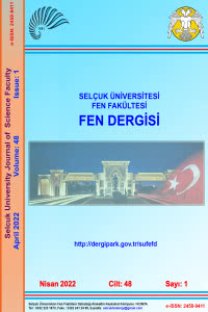Parçacık Sürü Optimizasyonuna Dayalı Sinir Ağları Kullanılarak Ultra Geniş Bant Kablosuz Kapsül Endoskopide Vücut İçi Mesafe Ölçümü
IN-BODY RANGING FOR ULTRA-WIDE BAND WIRELESS CAPSULE ENDOSCOPY USING NEURAL NETWORKS BASED ON PARTICLE SWARM OPTIMIZATION
___
- Alba, E., Marti, R., 2006, Metaheuristic Procedures for Training Neural Networks, Operations Research/Computer Science Interfaces Series, Springer, New York, NY, USA.
- Boussaïda, I., Lepagnot, J., Siarry, P., 2013, “A Survey on Optimization Metaheuristics”, Information Sciences, Vol. 237, pp. 82-117.
- Ch, S., Mathur S., 2012, “Particle Swarm Optimization Trained Neural Network for Aquifer Parameter Estimation”, KSCE Journal of Civil Engineering, Vol. 16, No. 3, pp. 298-307.
- Chavez-Santiago R., Balasingham I., “Computation of the Transmission Frequency Band for The Ultra Wideband Capsule Endoscope”, 7th International Symposium on Medical Information and Communication Technology (ISMICT), Tokyo, Japan, pp. 66-70, 6-8 March 2013.
- Chen, J., 2013, UWB Characteristics of RF Propagation for Body Mounted and Implanted Sensors, MSc Thesis, Worcester Polytechnic Institute, MA.
- Chen, J., Ye, Y., Pahlavan, K., “Comparison of UWB and NB RF Ranging Measurements in Homogenous Tissue for BAN Applications”, Wireless Telecommunications Symposium (WTS), Phoenix, Arizona, USA, pp.1-5, 17-19 April 2013.
- Dai, H., Ying, W. H., Xu, J., 2016, “Multi-layer Neural Network for Received Signal Strength-Based Indoor Localisation”, IET Communications, Vol. 10, No. 6, pp. 717-723.
- Fang, S. H., Lin, T. N., 2008, “Indoor Location System Based on Discriminant-Adaptive Neural Network in IEEE 802.11 Environments”, IEEE Transactions on Neural Networks, Vol. 19, No. 11, pp.1973- 1978.
- Garg, S., Patra, K., Pal, S. K., 2014, “Particle Swarm Optimization of a Neural Network Model in a Machining Process”, Sadhana, Vol. 39, No. 3, pp. 533-548.
- Garro, B. A., Vázquez, B. A., 2015, “Designing Artificial Neural Networks Using Particle Swarm Optimization Algorithms”, Computational Intelligence and Neuroscience, pp. 1-20, http://dx.doi.org/10.1155/2015/369298
- Jordehi, A. R., Jashi, J., 2013, “Parameter Selection in Particle Swarm Optimisation: a Survey”, Journal of Experimental & Theoretical Artificial Intelligence, Vol. 25, No. 4, pp.527–542.
- Kanaan, M., Suveren, M., “In-body Ranging for Ultra-Wide Band Wireless Capsule Endoscopy Using a Neural Network Architecture”, 10th International Symposium on Medical Information and Communication Technology (ISMICT), Worcester, USA, 1-5, 20-23 March 2016a.
- Kanaan, M., Suveren, M., “Ranging for In-Body Localization of Ultra Wide Band Wireless Endoscopy Capsules using Neural Networks”, 24th Signal Processing and Communication Application Conference, (SIU-2016), Zonguldak, Turkey, 16-19 May, 2016b.
- Kanaan, M., Suveren, M., “In-Body Ranging with Ultra-Wideband Signals: Techniques and Modeling of the Ranging Error”, 2017, Wireless Communications and Mobile Computing, 2017, pp. 1-15.
- Kanaan, M., Suveren, M., 2015, “A Novel Frequency-Dependent Path Loss Model for Ultra Wideband Implant Body Area Networks”, Measurement, Vol. 68, pp. 117-127.
- Kennedy, J., Eberhart, R., “Particle Swarm Optimisation”, IEEE International Conference on Neural Networks, WA, Australia, pp. 1942-1948, 27-1 December 1995.
- Khaleghi, A., Balasingham, I., 2009, “Improving in-Body Ultra Wideband Communication Using Near- Field Coupling of the Implanted Antenna”, Microwave and Optical Technology Letters, Vol. 51, pp. 585-589.
- Lee, J. Y., Scholtz, R. A, 2002, “Ranging in a Dense Multipath Environment Using an UWB Radio Link”, IEEE Journal on Selected Areas in Communications, Vol. 20, No.9, pp.1677-1683, DOI:10.1109/JSAC.2002.805060.
- Liu, C., Ouyang, C., Zhu, P., Tang, W., “An Adaptive Fuzzy Weight PSO Algorithm”, 2010 Fourth International Conference on Genetic and Evolutionary Computing, Shenzhen, China, pp. 8-10, 13-15 December 2010.
- Pahlavan, K., Levesque, A. H., 2005, Wireless Information Networks, 2nd Edition, John Wiley & Sons, Inc., Hoboken, New Jersey, USA.
- Shang, F., Champagne, B., Psaromiligkos, I., 2013, “Time of Arrival and Power Delay Profile Estimation for IR-UWB Systems”, Signal Processing, Vol. 93, pp.1317-1327, DOI: 10.1016/j.sigpro.2012.11.006.
- Shi, Y., Eberhart, R., “Empirical Study of Particle Swarm Optimisation”, IEEE International Conference on Computational Intelligence, Washington, USA, 1945–1950, 6-9 July 1999.
- Swain P., 2003, “Wireless capsule endoscopy”, Gut, Vol.52, p.iv48-iv50.
- Talbi, E., 2009, Metaheuristics: from Design to Implementation, John Wiley & Sons, Hoboken.
- Uy, N. Q., Hoai, N. X., Mckay, R., Tuan, P. M., “Initialising PSO with Randomised Lowdiscrepancy Sequences: The Comparative Results”, IEEE Congress on Evolutionary Computation, Singapore, pp. 1985–1992, 25-28 September 2007.
- Vesterstrom, J., Thomsen, R., “A Comparative Study of Differential Evolution, Particle Swarm Optimization, and Evolutionary Algorithms on Numerical Benchmark Problems”, Congress on Evolutionary Computation, Porrtland, pp. 1980-1987, 19-23 June 2004.
- Wang, J., Wang, Q., 2013, Body Area Communications: Channel Modeling, Communication Systems and EMC, John Wiley & Sons, Singapore.
- Xin, J., Chen, G., Hai, Y., “A Particle Swarm Optimiser with Multi-Stage Linearly Decreasing Inertia Weight”, In IEEE International Conference on Computational Sciences and Optimisation, Sanya,China, pp. 505–508, 24-26 April 2009.
- Yang, X. S., 2008, Nature-inspired Metaheuristic Algorithms, Luniver Press, UK.
- Yuce, M. R., Keong, H. C, Chae, M. S, 2009, “Wideband Communication for Implantable and Wearable Systems”, IEEE Transactions on Microwave Theory and Techniques, Vol. 57, No. 10, pp.2597-2604.
- ISSN: 2147-9364
- Yayın Aralığı: Yılda 2 Sayı
- Başlangıç: 2013
- Yayıncı: Selçuk Üniversitesi Mühendislik Fakültesi
MUZAFFER KANAAN, RÜŞTÜ AKAY, MEMDUH SUVEREN
Normalize Edilmiş Uzaklık Değerleri ile Hızlı K-ortalama Renkli Görüntü Segmentasyonu
Ali SAĞLAM, Nurdan AKHAN BAYKAN
PENCERE BOŞLUKLU PERDE DUVARLA GÜÇLENDİRİLMİŞ 1/3 ÖLÇEKLİ BETONARME ÇERÇEVELERİN DAVRANIŞI
FATİH SÜLEYMAN BALIK, FATİH BAHADIR, MEHMET KAMANLI, HASAN HÜSNÜ KORKMAZ, ALPTUĞ ÜNAL, M. Yaşar KALTAKCI
PVP-AŞILANMIŞ NiFe2O4 NANO PARÇACIKLARININ YÜZEY POLİMERİZASYONU TEKNİĞİ İLE SENTEZİ
SEMA VURAL, Aysel ALPHAN, SÜLEYMAN KÖYTEPE, TURGAY SEÇKİN
SARNIÇ KÖY (HAVRAN/BALIKESİR) ÇEVRESİNDEKİ ANDEZİTLERİN AYRIŞMA BOZUNMA AÇISINDAN İNCELENMESİ
FPGA TABANLI DİJİTAL HABERLEŞME SİSTEMLERİNİN SYSTEM GENERATOR ARACI İLE ANALİZİ
İBRAHİM IŞIK, MEHMET EMİN TAĞLUK
TÜRKAN ALTUN, ŞERİFE PARLAYICI
METİLEN MAVİSİNİN MAGNETİK NiFe2O4/AKTİF KARBON NANOKOMPOZİTİ İLE ADSORPSİYONU: KİNETİK VE İZOTERM
